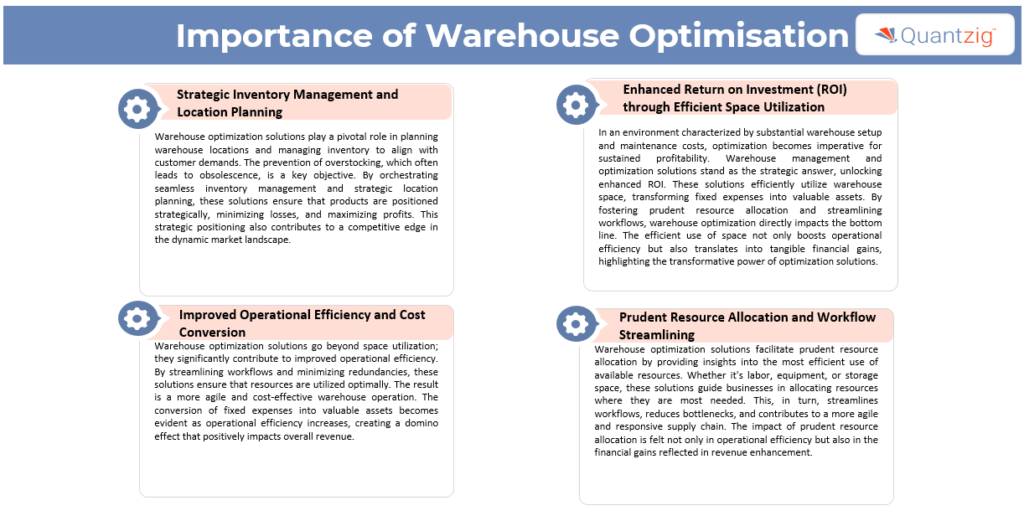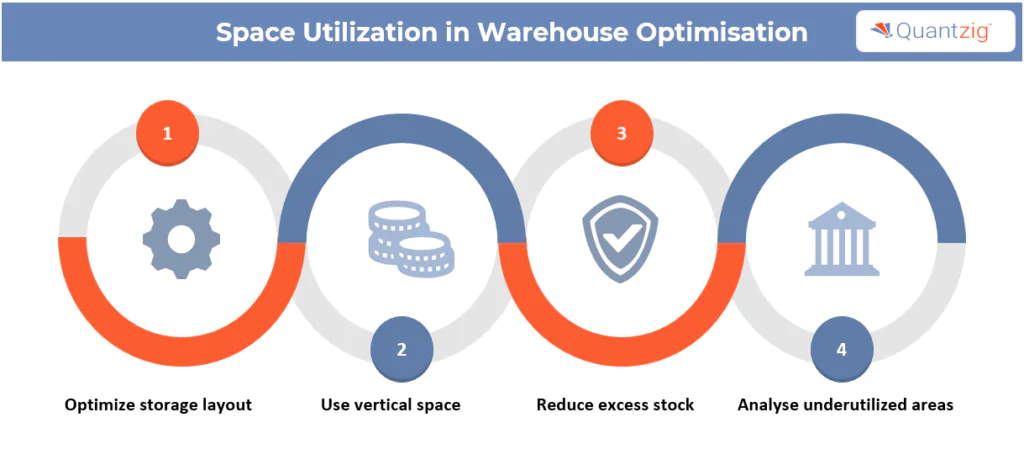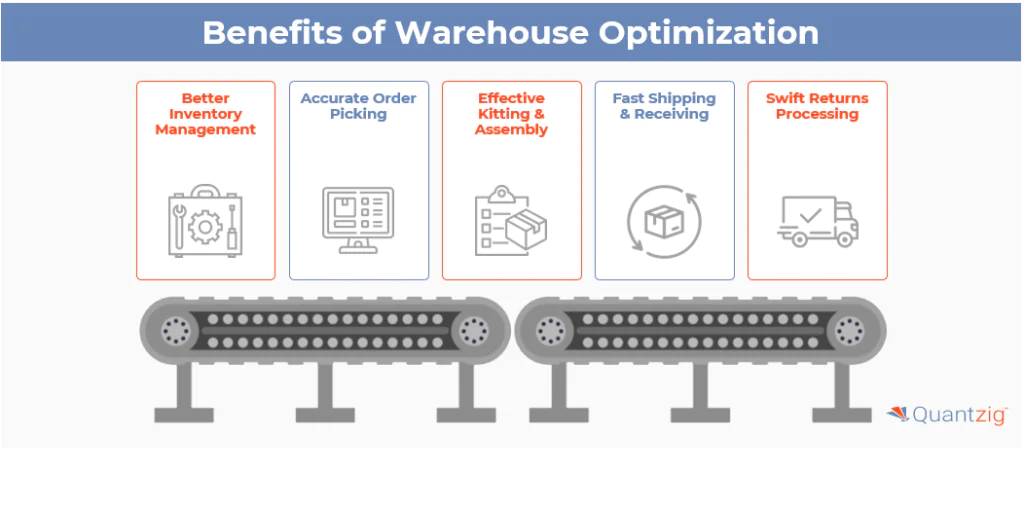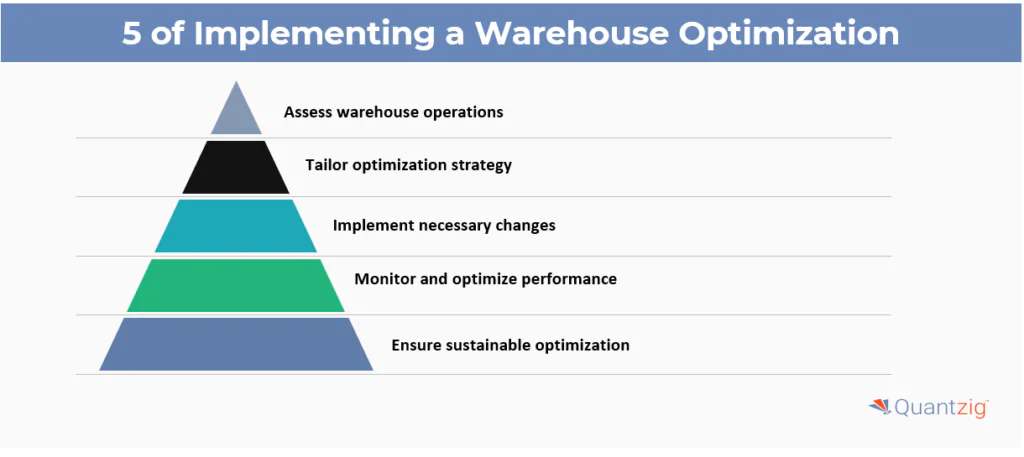Table of Contents:
- What is Warehouse Optimization?
- Importance of Warehouse Optimization Solutions for Revenue Enhancement
- Why You Should Optimize Your Warehouse
- The Benefits of Warehouse Optimization
- Tips for Optimizing a Warehouse
- Warehouse Optimization Checklist
- Implementing a Warehouse Optimization Plan
- Warehouse Optimization Trends To Watch
- Emerging Trends and the Future of Warehouse Management & Optimization
- Case Studies: Quantzig’s Warehouse Optimization Solutions in Action
Author: Medha Banerjee
As an expert in the field of warehouse optimization, Quantzig understands the critical role that efficient warehouse management plays in driving revenue growth and operational efficiency for businesses across industries. In this comprehensive guide, we’ll explore the key strategies and solutions that can help you unlock the full potential of your warehouse operations.
Table of Contents
What is Warehouse Optimization?
Warehouse optimization is the process of streamlining and improving the overall efficiency of a warehouse’s operations, from inventory management and storage to order fulfillment and logistics. By implementing a range of optimization techniques and technologies, businesses can enhance their warehouse’s productivity, reduce operational costs, and ultimately, boost their revenue.
In an era where supply chain dynamics shape the business landscape, the untapped potential within warehouses holds the key to unlocking unprecedented revenue streams. Warehouse optimization solutions harness cutting-edge technology and strategic insights to transform chaotic storage spaces into seamless hubs of efficiency, maximizing revenue and minimizing operational costs. It mainly deals with creating the following issues more efficiently: the use of space, time, and warehouse resources. The key purpose of such a warehouse optimizing shift is to improve customers’ experience and satisfaction significantly. This leads to revenue enhancement through more precise process automation and planning.
Book a demo to experience the meaningful insights we derive from data through our ai analytics tools and platform capabilities. Schedule a demo today!
Request a Free DemoImportance of Warehouse Optimization Solutions for Revenue Enhancement
Warehouse optimization is a crucial component of a successful business strategy, as it directly impacts a company’s bottom line. By optimizing warehouse operations, businesses can:

The importance of warehouse optimization solutions for revenue enhancement is multi-faceted. From strategic inventory management to efficient space utilization and improved operational efficiency, these solutions offer a comprehensive approach to achieving sustained profitability. In a competitive market, where every aspect of the supply chain matters, investing in warehouse optimization emerges as a strategic imperative for businesses aiming to thrive and succeed.
Why You Should Optimize Your Warehouse?
In today’s competitive business landscape, optimizing your warehouse operations is no longer a luxury, but a necessity. Warehouses that fail to keep up with the latest optimization strategies and technologies risk falling behind their competitors, losing market share, and ultimately, experiencing a decline in revenue.
By partnering with a trusted expert like Quantzig, you can unlock the full potential of your warehouse and drive sustainable growth for your business. Quantzig’s comprehensive warehouse optimization solutions are designed to address the unique challenges faced by organizations, leveraging data-driven insights, cutting-edge technologies, and proven best practices to deliver tangible results.
Experience the advantages firsthand by testing a customized complimentary pilot designed to address your specific requirements. Pilot studies are non-committal in nature.
Request a free pilotOptimizing Space Utilization
One of the key focus areas of warehouse optimization is maximizing the use of available space. Quantzig’s experts can help you implement strategies such as:

- Implementing a strategic storage layout to optimize product placement and accessibility
- Utilizing vertical space through the installation of high-density storage systems
- Optimizing inventory levels and reducing excess stock to free up valuable floor space
- Leveraging data analytics to identify and address underutilized areas within the warehouse
The Benefits of Warehouse Optimization
By partnering with Quantzig and implementing a comprehensive warehouse optimization strategy, businesses can expect to enjoy a wide range of benefits, including:

Implementing warehouse automation and process automation can significantly enhance warehouse efficiency. By leveraging artificial intelligence (AI) and big data, businesses can improve forecasting accuracy. Through comprehensive data analysis, organizations can gain insights to optimize their operations further.
Tips for Optimizing a Warehouse
Quantzig’s experts have identified the following key tips for optimizing a warehouse:
- Conduct a thorough assessment of your current warehouse operations
- Implement a robust inventory management system to maintain optimal stock levels
- Utilize data analytics to identify bottlenecks and opportunities for improvement
- Invest in automation and technology solutions to streamline workflows
- Optimize storage and layout to maximize space utilization
- Implement lean principles and continuous improvement processes
- Provide comprehensive training and development for warehouse staff
Warehouse Optimization Checklist
To help you get started, Quantzig has developed a comprehensive warehouse optimization checklist:
- Assess current warehouse operations and identify areas for improvement
- Implement a modern inventory management system
- Optimize storage layout and utilize vertical space
- Automate repetitive tasks and workflows
- Streamline order fulfillment and logistics processes
- Leverage data analytics to drive informed decision-making
- Continuously monitor and optimize warehouse performance
Key Steps of Implementing a Warehouse Optimization Plan
Quantzig’s proven approach to warehouse optimization involves the following key steps:

To boost warehouse efficiency, integrating warehouse automation and process automation is essential. Utilizing artificial intelligence (AI) and big data enables precise forecasting and enhances operational accuracy. Through thorough data analysis, businesses can continuously refine their processes and maintain optimal performance.
Warehouse Optimization Trends To Watch
As the world of warehouse management continues to evolve, Quantzig’s experts have identified the following key trends that businesses should be aware of:
- Increased adoption of automation and robotics
- Leveraging data analytics and AI for predictive decision-making
- Emphasis on sustainability and eco-friendly warehouse practices
- Integration of warehouse management with broader supply chain optimization
- Emergence of micro-fulfillment centers and urban warehousing
Emerging Trends and the Future of Warehouse Management & Optimization
Looking ahead, Quantzig anticipates that the future of warehouse management and optimization will be shaped by the following emerging trends:

- Widespread adoption of autonomous mobile robots (AMRs) and autonomous guided vehicles (AGVs) for material handling and order fulfillment
- Increased integration of warehouse management systems (WMS) with other enterprise software, such as ERP and CRM
- Utilization of advanced analytics and machine learning to optimize warehouse operations and predict future demand
- Emphasis on sustainable warehouse design and operations, including the use of renewable energy and eco-friendly materials
- Emergence of “smart warehouses” that leverage the Internet of Things (IoT) and real-time data to enhance visibility and control
By staying ahead of these trends and partnering with a trusted expert like Quantzig, businesses can position themselves for long-term success in the rapidly evolving world of warehouse management and optimization.
Case Studies: Quantzig’s Warehouse Optimization Solutions in Action
Case Study 1: Optimizing Space Utilization for a Leading Retail Chain
A leading retail chain was facing challenges with inefficient space utilization in their warehouses, leading to increased operational costs and reduced profitability. Quantzig’s experts conducted a comprehensive assessment of the client’s warehouse operations and implemented a strategic storage layout, high-density storage systems, and data-driven inventory optimization. As a result, the client achieved a 7% reduction in warehouse space requirements, a 5% increase in inventory turnover, and a 4% improvement in overall supply chain ROI.
Case Study 2: Improving Order Fulfillment Efficiency for a Global E-commerce Retailer
A global e-commerce retailer was struggling with delayed order fulfillment and high shipping costs due to inefficient warehouse operations. Quantzig’s team leveraged advanced analytics and automation solutions to streamline the client’s order fulfillment processes, optimize workflow, and enhance resource allocation. The result was a 12% reduction in order processing time, a 9% decrease in shipping costs, and a significant improvement in customer satisfaction.
Case Study 3: Enhancing Inventory Management for a Pharmaceutical Distributor
A leading pharmaceutical distributor faced challenges with inventory management, leading to stockouts, product expiration, and missed revenue opportunities. Quantzig’s experts implemented a robust inventory management system, integrated with the client’s warehouse operations. By leveraging data analytics and predictive modeling, the team was able to optimize inventory levels, reduce obsolescence, and improve on-time delivery. The client experienced a 6% increase in revenue, a 9% reduction in inventory carrying costs, and a 15% improvement in customer service levels.
Get started with your complimentary trial today and delve into our platform without any obligations. Explore our wide range of customized, consumption driven analytical solutions services built across the analytical maturity levels.
Start your free trialThrough these case studies, Quantzig has been able to demonstrate its expertise in delivering comprehensive warehouse optimization solutions that drive tangible business results for clients across various industries. By partnering with Quantzig, businesses can unlock the full potential of their warehouse operations and position themselves for long-term success and revenue growth.



